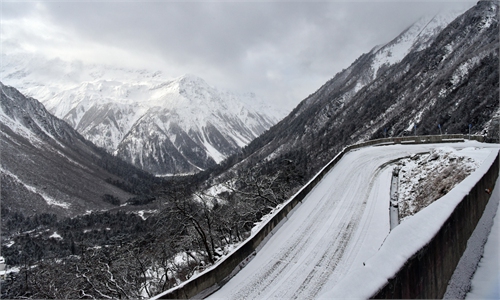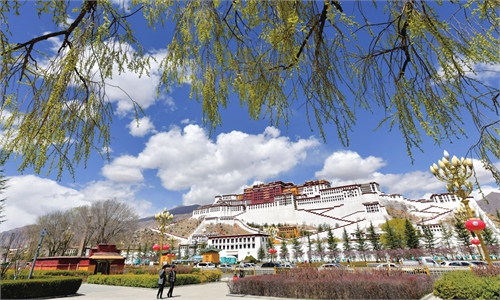Departments merged in Xizang to improve efficiency and benefit local stability, ecological improvement and border management

On March 23, 2024, as temperatures warmed up, spring was in full swing in Lhasa, with willow trees sprouting green at the foot of the Potala Palace. Photo: VCG
Southwest China's Xizang Autonomous Region has recently merged multiple local government departments in its small-populated counties and streamlined the institutions, a move which an expert said will benefit the stability, development and ecological work in these counties as well as intensification of border management.
During the reform, multiple counties including Baxoi and Dengqen in the city of Qamdo, Gerze, Ge'gyai and Gar in Ngari Prefecture have accomplished the merger of multiple government departments, optimizing resource allocation and making the government bodies work more efficiently.
On July 8, Baxoi officially unveiled several new government departments, which were merged by multiple government bodies. Such newly merged departments include the bureau of development, reform, economy, information technology and commerce, the bureau of agriculture, rural affairs, science and technology and water resources, and the bureau of civil affairs and veterans affairs.
Baxoi locates in the eastern part of Xizang and covers an area of 12,330 square kilometers with the jurisdiction of 14 townships. Data from China's seventh national population census showed that there are 43,538 permanent residents in the county.
The setup of the bureau of development, reform, economy, information technology and commerce in Baxoi aims to implement the requirements for Party and government institution reform in counties with a small population, local officials said.
Meanwhile, the merge of the departments of agriculture and rural affairs, science and technology, water resources into one bureau is to form overall coordination and optimize personnel allocation.
Besides, the merge of civil affairs and veterans affairs departments into one bureau was a move to promote the integration of departments with similar functions, official said.
The county of Gar in Ngari prefecture locates in the western part of Xizang and borders the Indian-controlled Kashmir region to the west. The county's total area is 18,080 square kilometers with a population of 24,910 by the end of 2020.
The vast area and sparse population of Xizang have historically led to an institutional setup that can result in significant waste of administrative resources and government finances, Zhang Yongpan, a research fellow of the Institute of Chinese Borderland Studies of the Chinese Academy of Social Sciences, told the Global Times on Wednesday. However, by merging certain departments, the efficiency of government operations can be enhanced, thereby minimizing waste and optimizing resource allocation. This approach not only streamlines administrative processes but also ensures that public funds are used more effectively, said Zhang, , noting that such an institutional reform will benefit the region's stability and development, as well as its ecological work and intensification of border management.
According to Zhang, the institutional reform in the border area can also promote the increase in funding and boost innovations in border construction, accelerate the improvement of major infrastructures such as water, electricity, roads and communications, speed up the development of land routes for China's opening-up to South Asia, and foster cross-border cultural exchange and tourism.
Besides, the functions of many administrative organs in Xizang's border counties are similar, Zhang said, noting that the merge of multiple departments such as development, reform, economy and commerce into one united department will improve the efficiency of the department.
Besides, merging different departments with overlapping functions, such as the civil affairs and veterans affairs departments, will benefit the stability of the county, the harmony of society and the well-being of the local people.
This round of institutional reform started in North China's Shanxi Province aims to reduce administrative costs and financial burdens through reforms. At present, several counties in Shanxi and Northwest China's Qinghai Province have accomplished the reform, with more provinces such as Central China's Hunan and Northwest China's Gansu Province expected to follow suit.



